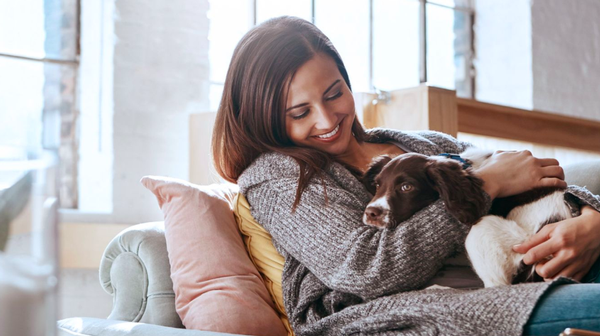How to Help Your Dog Adjust to Your New Home
How to Help Your Dog Adjust to Your New Home
Moving to a new home is exciting! At the same time, it also brings a lot of change to your current routine and environment. As you plan for your big move, it’s important that you take the proper steps to make it a success for your pup, too.
We sat down with Christine Fox, CEO of Wag’n’Tails Dog Activity Center, to gather the best ways to help your dog adjust to their new home.
Preparing Your Dog for Your Move
Before you get the keys to your new house, follow the tips below to make sure you and your pup are ready.
Update your pup’s microchip. Unlike a collar, a microchip provides a permanent ID that can’t fall off, be removed, or become impossible to read. Make sure you update your dog’s microchip with your new address. If you have a brand-new puppy or a dog who hasn’t been microchipped, you can contact your local veterinarian to have one implanted. Many people choose to have this done with another procedure, such as when their pet is spayed or neutered.
Gather all their documentation. Keep all your pet’s documentation together so you don’t lose anything in the moving process. This includes your pet’s vaccine records, emergency contact information, county license and any other medical records you have for them. This will be important to have on hand when you register your pup with the new county you’re moving to.
License your dog in your new county. If you are moving to a new county, you’ll want to make sure you get a new license for your pet as soon as possible. If you call your local county’s office, they will help you through the process. You typically will need to show that your pup has up-to-date vaccinations, along with providing your name and contact information.
Change their ID tags. Make sure that you’re prepared to change your pup’s ID tags as well, especially if your dog isn’t microchipped. This will give you peace of mind that if your dog ever gets lost, that anyone who finds them will know how to get in touch with you.
Moving Day Tips for Success
Now that you’ve prepared as much as you can for the move, it’s time to think about what you’ll do with your dog on the big day.
Leave the pet with someone while you pack and move. According to Fox, having a family member or friend watch your pet during the moving process is one of the most important things you can do. “As calm as you think the day might go, you’re under a lot of stress and pressure. It’s new for you, too. Dogs can pick up on that” said Fox. “The more worked up you are, the more worked up the dog will be. Always.”
Make sure your dog is confined. If you aren’t able to take your dog anywhere during the move, make sure they are closed in a bedroom or somewhere safe. You don’t want them running out the door or into the street as you’re moving all your belongings.
Turn everything into something fun with the use of food. Place treat containers all over your current house and your new one. That way, as you’re packing or moving things around, you show them that it’s not so bad. This turns a stressful situation into a positive one for your pet.
Introduce your dog to the movers. Make sure you introduce your dog to anyone helping you move. It’s a good idea to have your movers give your pup a few treats and be aware of where all the treat containers are. That way, your dog is less likely to get worked up or be vocal throughout the process.
Consider purchasing stress-relieving products for your pup. Talk to your local veterinarian about the use of a lavender collar, infusers, or other anxiety-reducing products. These items can go a long way in making sure your pet is relaxed and happy during such a time of change.
Have everything for your pet labeled and ready to go. Make sure your pet’s crate, bed, bowls, leash, collars, baby gates and any of their other belongings are clearly labeled so that you can easily unpack them at the new house.
Preventing Unwanted Behavioral Problems after Your Move
There are steps you can take to help make sure your dog doesn’t experience behavioral problems after you move, such as loss of appetite or (gasp!) having accidents in your new home.
Keep things the same. Until your pup feels safe and adjusted to their new surroundings, resist the urge to bring any new toys, bedding or other items to your new home. For example, if your pup is used to ringing a bell before they go outside to potty, make sure you bring that with you and replicate that same process as closely as possible. This will help them have a sense of familiarity and make their transition to their new home less scary.
Use plenty of positive reinforcement. Once you’ve moved and you’re ready to go back to work, have a plan in place to help your dog while you’re away. Having bones or Kong’s filled with treats ready to go will make the time you’re gone easier on your pet. This helps them to feel less lonely and isolated, especially in the first days you are away.
Consider enrolling your dog in a training and daycare center. One way to help your dog adjust to their new city is to help them make friends. Taking your pet to a dog activity center during the day will help them adjust better, get lots of exercise and play time and blow off steam which helps turn a stressful situation into something they look forward to.
Downplay your comings and goings. Once you get home, it’s important that you unwind for a moment before greeting your dog. Set down your keys, pick up your mail, go to the bathroom, or whatever it is that you typically do when you walk in the door first. If you make a big deal when you come and go, then you’re teaching your dog that when you’re there it’s wonderful and when you’re away it’s lonely and stressful.
Limit their access to the house. A whole house, especially a whole new house, can be overwhelming to a dog. They don’t need access to it all at first. Try gating them in just one area – such as the kitchen or living room. Then over time, allow them to explore more rooms and areas. This creates less anxiety and makes it easier for your pet to adjust.
Think about how to make your new home pet friendly. There are ways you can help create a home that both you and your furry friend love. Now that you have a blank slate in your new home, check out these ways to make your home both stylish and dog friendly.
How to Know Your Dog is Happy and Healthy in their New Home
There are signs your dog will display to let you know they’ve adjusted to their new home. If you notice any of the following behaviors, you know you’re in the clear!
- Less pacing, panting, barking and anxiety with comings and goings
- Sleeping longer through the night
- Looking out the windows less
Every dog will adjust to their new homes differently. Some may be comfortable right away, and others may need a little more time. Be sure to consult with your vet or dog trainer before moving day. They’ll be able to give you the best advice for your individual dog.


